Assessment 2: Guided Review of Literature
VerifiedAdded on 2023/01/19
|14
|2896
|85
AI Summary
This assessment provides a guided review of nominated literature on qualitative and quantitative studies. It explores the aim and significance of the studies, the methods used, data collection and analysis, and the findings and limitations of the studies.
Contribute Materials
Your contribution can guide someone’s learning journey. Share your
documents today.
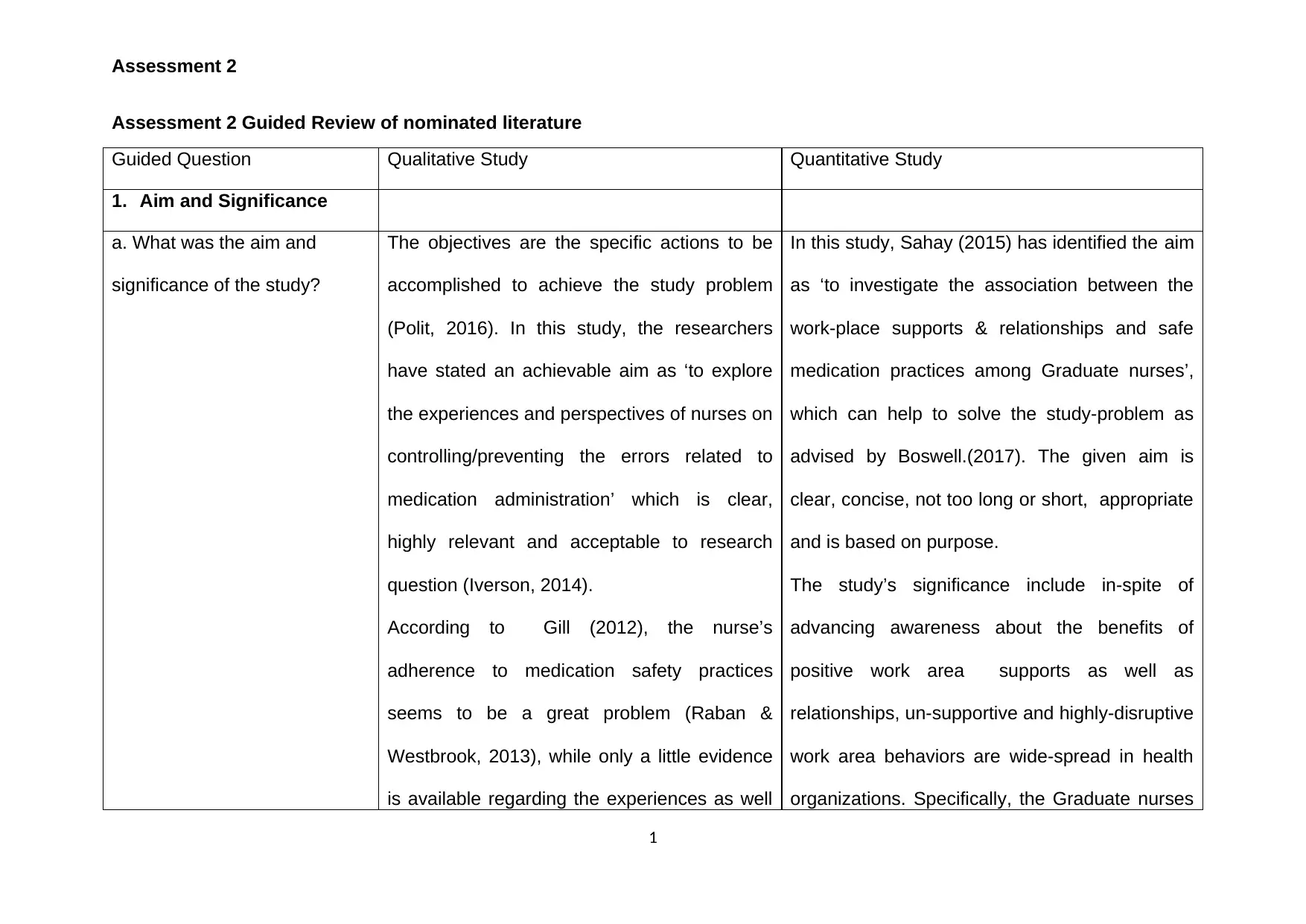
Assessment 2
Assessment 2 Guided Review of nominated literature
Guided Question Qualitative Study Quantitative Study
1. Aim and Significance
a. What was the aim and
significance of the study?
The objectives are the specific actions to be
accomplished to achieve the study problem
(Polit, 2016). In this study, the researchers
have stated an achievable aim as ‘to explore
the experiences and perspectives of nurses on
controlling/preventing the errors related to
medication administration’ which is clear,
highly relevant and acceptable to research
question (Iverson, 2014).
According to Gill (2012), the nurse’s
adherence to medication safety practices
seems to be a great problem (Raban &
Westbrook, 2013), while only a little evidence
is available regarding the experiences as well
In this study, Sahay (2015) has identified the aim
as ‘to investigate the association between the
work-place supports & relationships and safe
medication practices among Graduate nurses’,
which can help to solve the study-problem as
advised by Boswell.(2017). The given aim is
clear, concise, not too long or short, appropriate
and is based on purpose.
The study’s significance include in-spite of
advancing awareness about the benefits of
positive work area supports as well as
relationships, un-supportive and highly-disruptive
work area behaviors are wide-spread in health
organizations. Specifically, the Graduate nurses
1
Assessment 2 Guided Review of nominated literature
Guided Question Qualitative Study Quantitative Study
1. Aim and Significance
a. What was the aim and
significance of the study?
The objectives are the specific actions to be
accomplished to achieve the study problem
(Polit, 2016). In this study, the researchers
have stated an achievable aim as ‘to explore
the experiences and perspectives of nurses on
controlling/preventing the errors related to
medication administration’ which is clear,
highly relevant and acceptable to research
question (Iverson, 2014).
According to Gill (2012), the nurse’s
adherence to medication safety practices
seems to be a great problem (Raban &
Westbrook, 2013), while only a little evidence
is available regarding the experiences as well
In this study, Sahay (2015) has identified the aim
as ‘to investigate the association between the
work-place supports & relationships and safe
medication practices among Graduate nurses’,
which can help to solve the study-problem as
advised by Boswell.(2017). The given aim is
clear, concise, not too long or short, appropriate
and is based on purpose.
The study’s significance include in-spite of
advancing awareness about the benefits of
positive work area supports as well as
relationships, un-supportive and highly-disruptive
work area behaviors are wide-spread in health
organizations. Specifically, the Graduate nurses
1
Secure Best Marks with AI Grader
Need help grading? Try our AI Grader for instant feedback on your assignments.
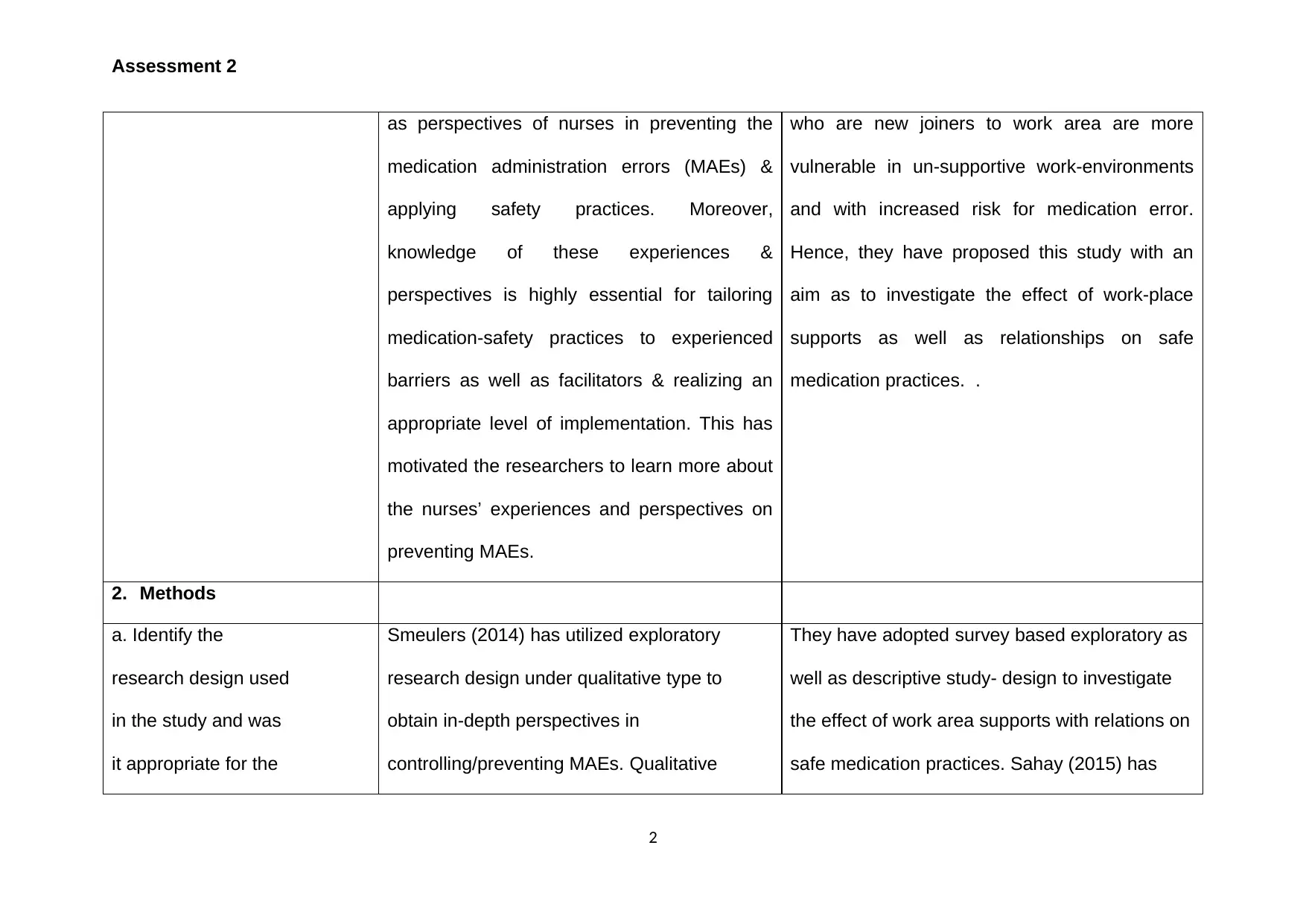
Assessment 2
as perspectives of nurses in preventing the
medication administration errors (MAEs) &
applying safety practices. Moreover,
knowledge of these experiences &
perspectives is highly essential for tailoring
medication-safety practices to experienced
barriers as well as facilitators & realizing an
appropriate level of implementation. This has
motivated the researchers to learn more about
the nurses’ experiences and perspectives on
preventing MAEs.
who are new joiners to work area are more
vulnerable in un-supportive work-environments
and with increased risk for medication error.
Hence, they have proposed this study with an
aim as to investigate the effect of work-place
supports as well as relationships on safe
medication practices. .
2. Methods
a. Identify the
research design used
in the study and was
it appropriate for the
Smeulers (2014) has utilized exploratory
research design under qualitative type to
obtain in-depth perspectives in
controlling/preventing MAEs. Qualitative
They have adopted survey based exploratory as
well as descriptive study- design to investigate
the effect of work area supports with relations on
safe medication practices. Sahay (2015) has
2
as perspectives of nurses in preventing the
medication administration errors (MAEs) &
applying safety practices. Moreover,
knowledge of these experiences &
perspectives is highly essential for tailoring
medication-safety practices to experienced
barriers as well as facilitators & realizing an
appropriate level of implementation. This has
motivated the researchers to learn more about
the nurses’ experiences and perspectives on
preventing MAEs.
who are new joiners to work area are more
vulnerable in un-supportive work-environments
and with increased risk for medication error.
Hence, they have proposed this study with an
aim as to investigate the effect of work-place
supports as well as relationships on safe
medication practices. .
2. Methods
a. Identify the
research design used
in the study and was
it appropriate for the
Smeulers (2014) has utilized exploratory
research design under qualitative type to
obtain in-depth perspectives in
controlling/preventing MAEs. Qualitative
They have adopted survey based exploratory as
well as descriptive study- design to investigate
the effect of work area supports with relations on
safe medication practices. Sahay (2015) has
2
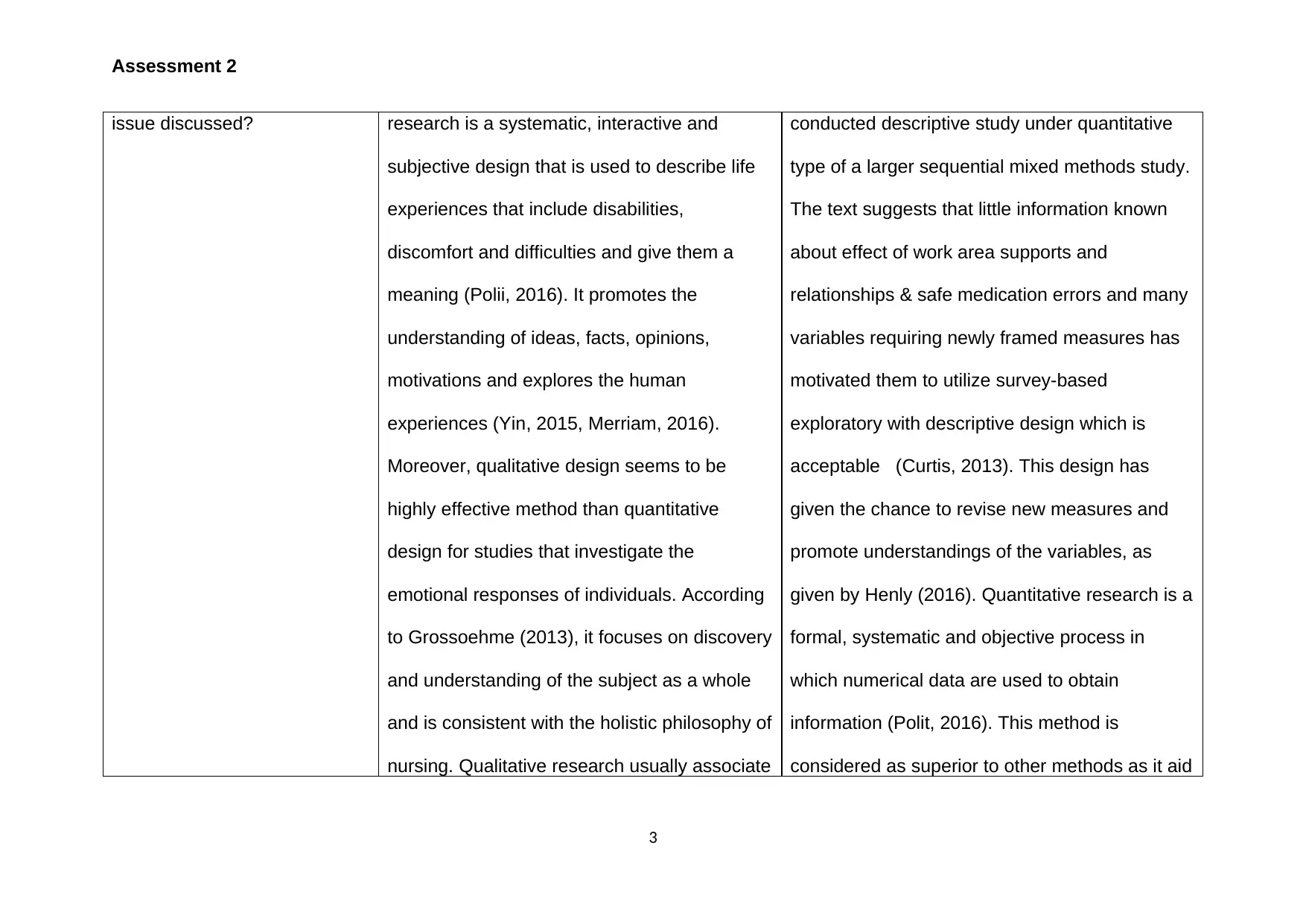
Assessment 2
issue discussed? research is a systematic, interactive and
subjective design that is used to describe life
experiences that include disabilities,
discomfort and difficulties and give them a
meaning (Polii, 2016). It promotes the
understanding of ideas, facts, opinions,
motivations and explores the human
experiences (Yin, 2015, Merriam, 2016).
Moreover, qualitative design seems to be
highly effective method than quantitative
design for studies that investigate the
emotional responses of individuals. According
to Grossoehme (2013), it focuses on discovery
and understanding of the subject as a whole
and is consistent with the holistic philosophy of
nursing. Qualitative research usually associate
conducted descriptive study under quantitative
type of a larger sequential mixed methods study.
The text suggests that little information known
about effect of work area supports and
relationships & safe medication errors and many
variables requiring newly framed measures has
motivated them to utilize survey-based
exploratory with descriptive design which is
acceptable (Curtis, 2013). This design has
given the chance to revise new measures and
promote understandings of the variables, as
given by Henly (2016). Quantitative research is a
formal, systematic and objective process in
which numerical data are used to obtain
information (Polit, 2016). This method is
considered as superior to other methods as it aid
3
issue discussed? research is a systematic, interactive and
subjective design that is used to describe life
experiences that include disabilities,
discomfort and difficulties and give them a
meaning (Polii, 2016). It promotes the
understanding of ideas, facts, opinions,
motivations and explores the human
experiences (Yin, 2015, Merriam, 2016).
Moreover, qualitative design seems to be
highly effective method than quantitative
design for studies that investigate the
emotional responses of individuals. According
to Grossoehme (2013), it focuses on discovery
and understanding of the subject as a whole
and is consistent with the holistic philosophy of
nursing. Qualitative research usually associate
conducted descriptive study under quantitative
type of a larger sequential mixed methods study.
The text suggests that little information known
about effect of work area supports and
relationships & safe medication errors and many
variables requiring newly framed measures has
motivated them to utilize survey-based
exploratory with descriptive design which is
acceptable (Curtis, 2013). This design has
given the chance to revise new measures and
promote understandings of the variables, as
given by Henly (2016). Quantitative research is a
formal, systematic and objective process in
which numerical data are used to obtain
information (Polit, 2016). This method is
considered as superior to other methods as it aid
3
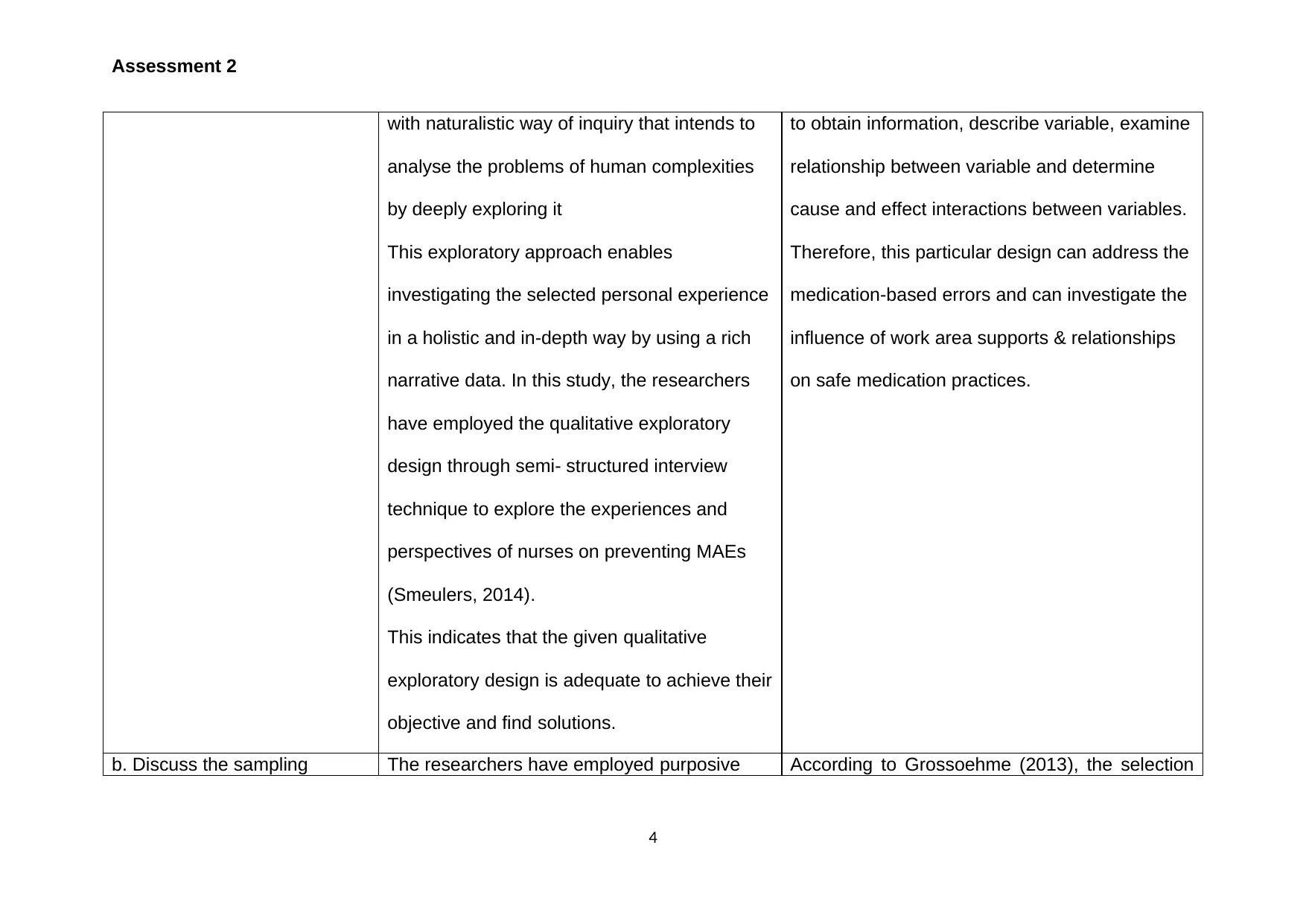
Assessment 2
with naturalistic way of inquiry that intends to
analyse the problems of human complexities
by deeply exploring it
This exploratory approach enables
investigating the selected personal experience
in a holistic and in-depth way by using a rich
narrative data. In this study, the researchers
have employed the qualitative exploratory
design through semi- structured interview
technique to explore the experiences and
perspectives of nurses on preventing MAEs
(Smeulers, 2014).
This indicates that the given qualitative
exploratory design is adequate to achieve their
objective and find solutions.
to obtain information, describe variable, examine
relationship between variable and determine
cause and effect interactions between variables.
Therefore, this particular design can address the
medication-based errors and can investigate the
influence of work area supports & relationships
on safe medication practices.
b. Discuss the sampling The researchers have employed purposive According to Grossoehme (2013), the selection
4
with naturalistic way of inquiry that intends to
analyse the problems of human complexities
by deeply exploring it
This exploratory approach enables
investigating the selected personal experience
in a holistic and in-depth way by using a rich
narrative data. In this study, the researchers
have employed the qualitative exploratory
design through semi- structured interview
technique to explore the experiences and
perspectives of nurses on preventing MAEs
(Smeulers, 2014).
This indicates that the given qualitative
exploratory design is adequate to achieve their
objective and find solutions.
to obtain information, describe variable, examine
relationship between variable and determine
cause and effect interactions between variables.
Therefore, this particular design can address the
medication-based errors and can investigate the
influence of work area supports & relationships
on safe medication practices.
b. Discuss the sampling The researchers have employed purposive According to Grossoehme (2013), the selection
4
Paraphrase This Document
Need a fresh take? Get an instant paraphrase of this document with our AI Paraphraser
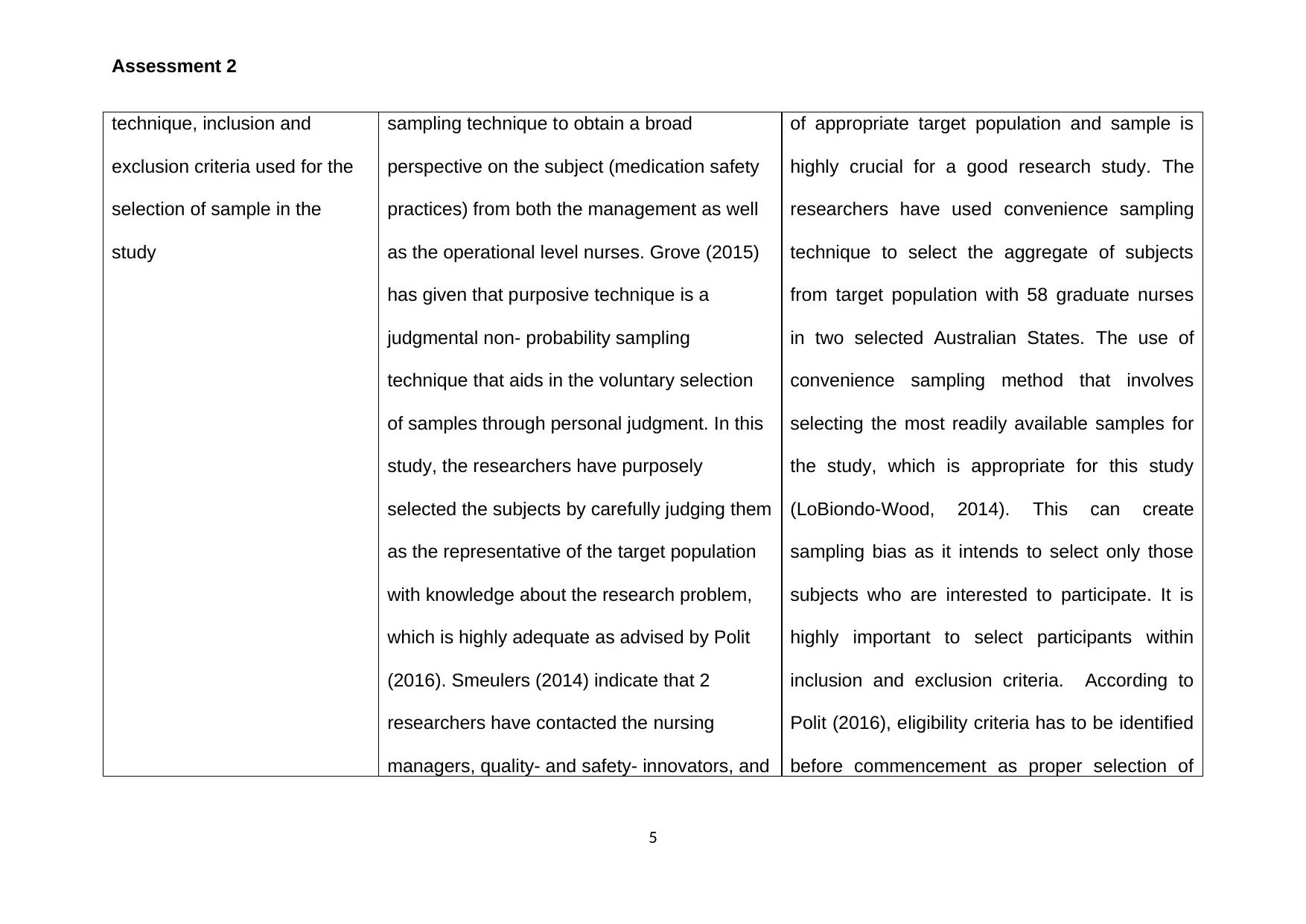
Assessment 2
technique, inclusion and
exclusion criteria used for the
selection of sample in the
study
sampling technique to obtain a broad
perspective on the subject (medication safety
practices) from both the management as well
as the operational level nurses. Grove (2015)
has given that purposive technique is a
judgmental non- probability sampling
technique that aids in the voluntary selection
of samples through personal judgment. In this
study, the researchers have purposely
selected the subjects by carefully judging them
as the representative of the target population
with knowledge about the research problem,
which is highly adequate as advised by Polit
(2016). Smeulers (2014) indicate that 2
researchers have contacted the nursing
managers, quality- and safety- innovators, and
of appropriate target population and sample is
highly crucial for a good research study. The
researchers have used convenience sampling
technique to select the aggregate of subjects
from target population with 58 graduate nurses
in two selected Australian States. The use of
convenience sampling method that involves
selecting the most readily available samples for
the study, which is appropriate for this study
(LoBiondo-Wood, 2014). This can create
sampling bias as it intends to select only those
subjects who are interested to participate. It is
highly important to select participants within
inclusion and exclusion criteria. According to
Polit (2016), eligibility criteria has to be identified
before commencement as proper selection of
5
technique, inclusion and
exclusion criteria used for the
selection of sample in the
study
sampling technique to obtain a broad
perspective on the subject (medication safety
practices) from both the management as well
as the operational level nurses. Grove (2015)
has given that purposive technique is a
judgmental non- probability sampling
technique that aids in the voluntary selection
of samples through personal judgment. In this
study, the researchers have purposely
selected the subjects by carefully judging them
as the representative of the target population
with knowledge about the research problem,
which is highly adequate as advised by Polit
(2016). Smeulers (2014) indicate that 2
researchers have contacted the nursing
managers, quality- and safety- innovators, and
of appropriate target population and sample is
highly crucial for a good research study. The
researchers have used convenience sampling
technique to select the aggregate of subjects
from target population with 58 graduate nurses
in two selected Australian States. The use of
convenience sampling method that involves
selecting the most readily available samples for
the study, which is appropriate for this study
(LoBiondo-Wood, 2014). This can create
sampling bias as it intends to select only those
subjects who are interested to participate. It is
highly important to select participants within
inclusion and exclusion criteria. According to
Polit (2016), eligibility criteria has to be identified
before commencement as proper selection of
5
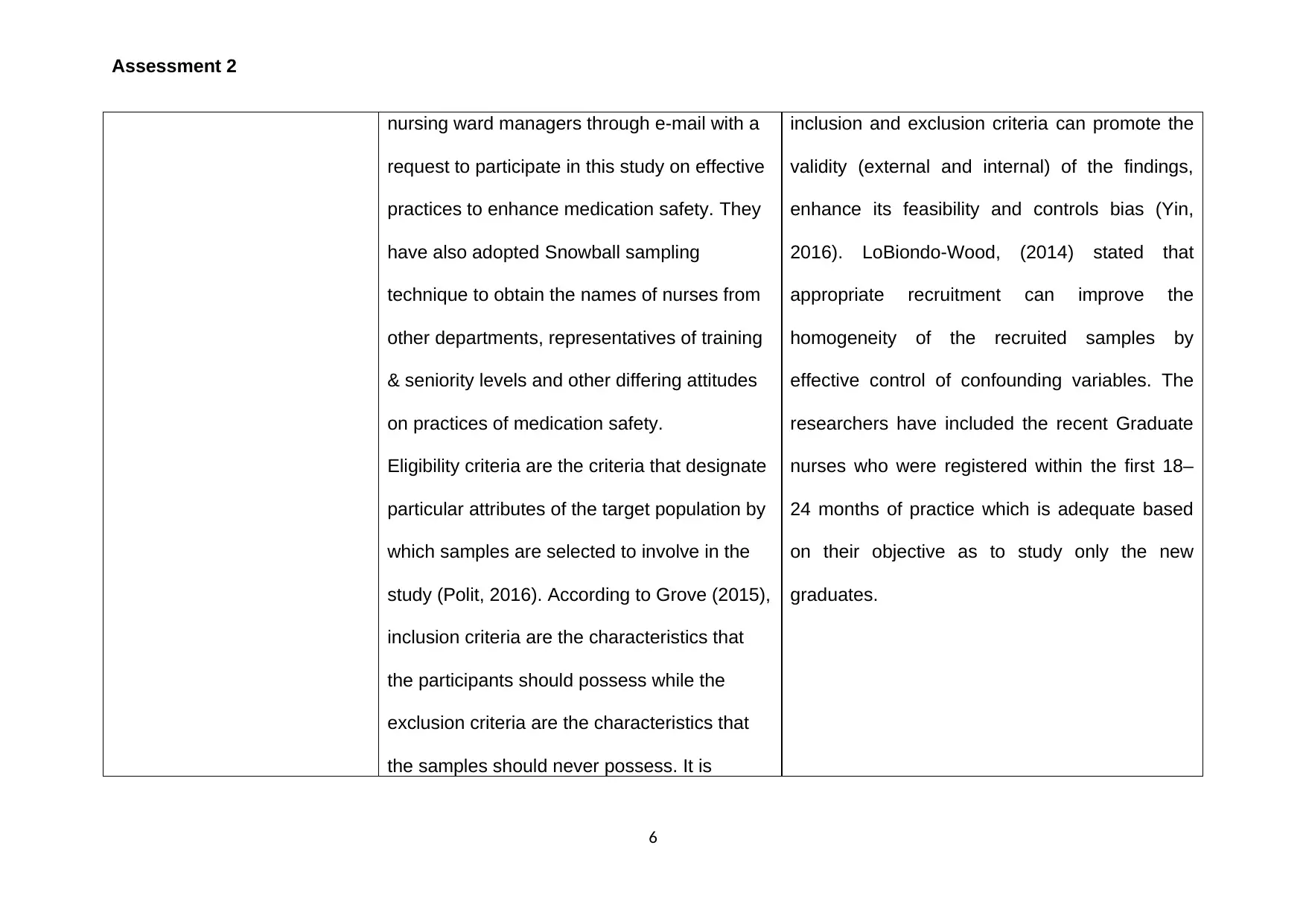
Assessment 2
nursing ward managers through e-mail with a
request to participate in this study on effective
practices to enhance medication safety. They
have also adopted Snowball sampling
technique to obtain the names of nurses from
other departments, representatives of training
& seniority levels and other differing attitudes
on practices of medication safety.
Eligibility criteria are the criteria that designate
particular attributes of the target population by
which samples are selected to involve in the
study (Polit, 2016). According to Grove (2015),
inclusion criteria are the characteristics that
the participants should possess while the
exclusion criteria are the characteristics that
the samples should never possess. It is
inclusion and exclusion criteria can promote the
validity (external and internal) of the findings,
enhance its feasibility and controls bias (Yin,
2016). LoBiondo-Wood, (2014) stated that
appropriate recruitment can improve the
homogeneity of the recruited samples by
effective control of confounding variables. The
researchers have included the recent Graduate
nurses who were registered within the first 18–
24 months of practice which is adequate based
on their objective as to study only the new
graduates.
6
nursing ward managers through e-mail with a
request to participate in this study on effective
practices to enhance medication safety. They
have also adopted Snowball sampling
technique to obtain the names of nurses from
other departments, representatives of training
& seniority levels and other differing attitudes
on practices of medication safety.
Eligibility criteria are the criteria that designate
particular attributes of the target population by
which samples are selected to involve in the
study (Polit, 2016). According to Grove (2015),
inclusion criteria are the characteristics that
the participants should possess while the
exclusion criteria are the characteristics that
the samples should never possess. It is
inclusion and exclusion criteria can promote the
validity (external and internal) of the findings,
enhance its feasibility and controls bias (Yin,
2016). LoBiondo-Wood, (2014) stated that
appropriate recruitment can improve the
homogeneity of the recruited samples by
effective control of confounding variables. The
researchers have included the recent Graduate
nurses who were registered within the first 18–
24 months of practice which is adequate based
on their objective as to study only the new
graduates.
6
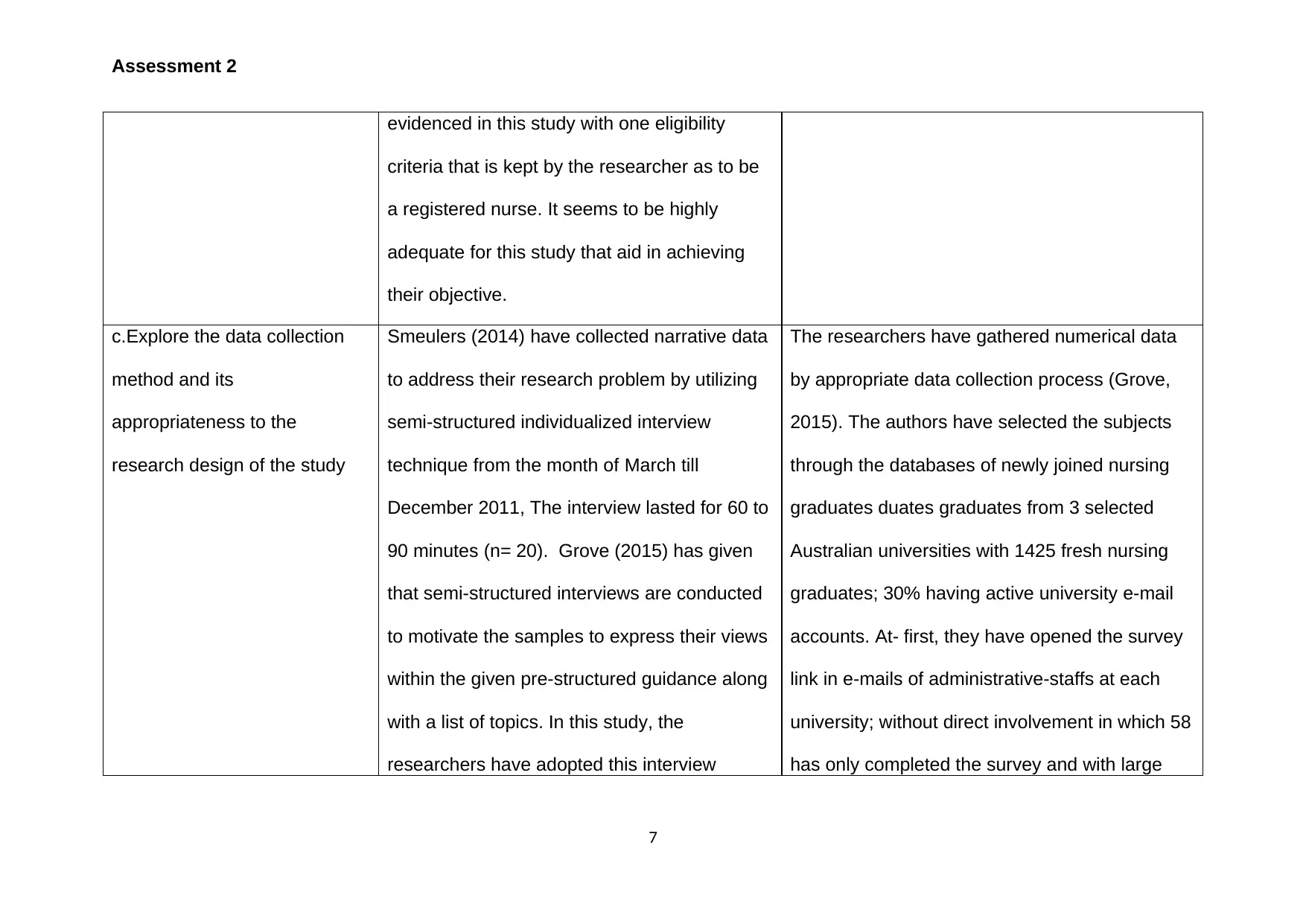
Assessment 2
evidenced in this study with one eligibility
criteria that is kept by the researcher as to be
a registered nurse. It seems to be highly
adequate for this study that aid in achieving
their objective.
c.Explore the data collection
method and its
appropriateness to the
research design of the study
Smeulers (2014) have collected narrative data
to address their research problem by utilizing
semi-structured individualized interview
technique from the month of March till
December 2011, The interview lasted for 60 to
90 minutes (n= 20). Grove (2015) has given
that semi-structured interviews are conducted
to motivate the samples to express their views
within the given pre-structured guidance along
with a list of topics. In this study, the
researchers have adopted this interview
The researchers have gathered numerical data
by appropriate data collection process (Grove,
2015). The authors have selected the subjects
through the databases of newly joined nursing
graduates duates graduates from 3 selected
Australian universities with 1425 fresh nursing
graduates; 30% having active university e-mail
accounts. At- first, they have opened the survey
link in e-mails of administrative-staffs at each
university; without direct involvement in which 58
has only completed the survey and with large
7
evidenced in this study with one eligibility
criteria that is kept by the researcher as to be
a registered nurse. It seems to be highly
adequate for this study that aid in achieving
their objective.
c.Explore the data collection
method and its
appropriateness to the
research design of the study
Smeulers (2014) have collected narrative data
to address their research problem by utilizing
semi-structured individualized interview
technique from the month of March till
December 2011, The interview lasted for 60 to
90 minutes (n= 20). Grove (2015) has given
that semi-structured interviews are conducted
to motivate the samples to express their views
within the given pre-structured guidance along
with a list of topics. In this study, the
researchers have adopted this interview
The researchers have gathered numerical data
by appropriate data collection process (Grove,
2015). The authors have selected the subjects
through the databases of newly joined nursing
graduates duates graduates from 3 selected
Australian universities with 1425 fresh nursing
graduates; 30% having active university e-mail
accounts. At- first, they have opened the survey
link in e-mails of administrative-staffs at each
university; without direct involvement in which 58
has only completed the survey and with large
7
Secure Best Marks with AI Grader
Need help grading? Try our AI Grader for instant feedback on your assignments.
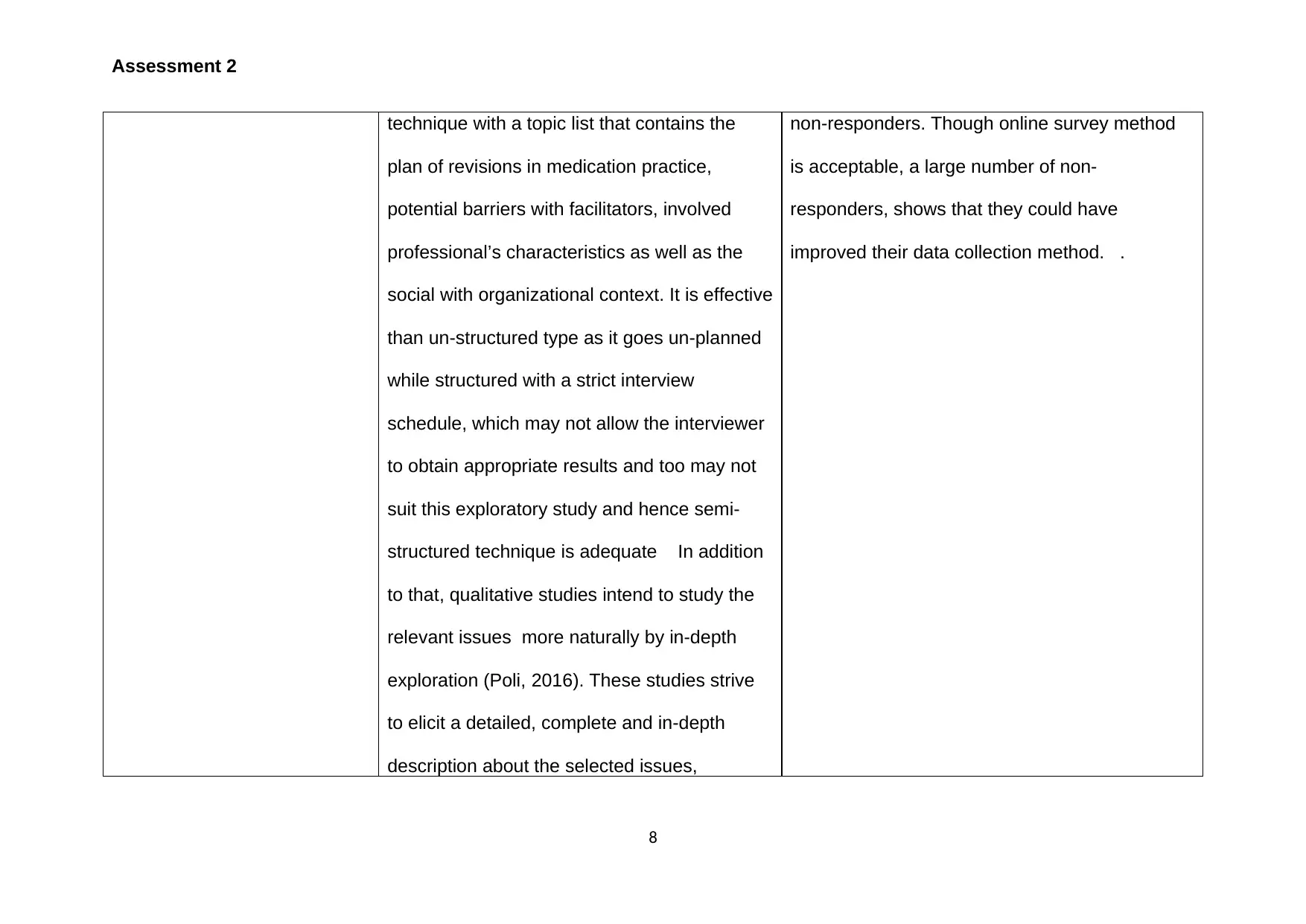
Assessment 2
technique with a topic list that contains the
plan of revisions in medication practice,
potential barriers with facilitators, involved
professional’s characteristics as well as the
social with organizational context. It is effective
than un-structured type as it goes un-planned
while structured with a strict interview
schedule, which may not allow the interviewer
to obtain appropriate results and too may not
suit this exploratory study and hence semi-
structured technique is adequate In addition
to that, qualitative studies intend to study the
relevant issues more naturally by in-depth
exploration (Poli, 2016). These studies strive
to elicit a detailed, complete and in-depth
description about the selected issues,
non-responders. Though online survey method
is acceptable, a large number of non-
responders, shows that they could have
improved their data collection method. .
8
technique with a topic list that contains the
plan of revisions in medication practice,
potential barriers with facilitators, involved
professional’s characteristics as well as the
social with organizational context. It is effective
than un-structured type as it goes un-planned
while structured with a strict interview
schedule, which may not allow the interviewer
to obtain appropriate results and too may not
suit this exploratory study and hence semi-
structured technique is adequate In addition
to that, qualitative studies intend to study the
relevant issues more naturally by in-depth
exploration (Poli, 2016). These studies strive
to elicit a detailed, complete and in-depth
description about the selected issues,
non-responders. Though online survey method
is acceptable, a large number of non-
responders, shows that they could have
improved their data collection method. .
8
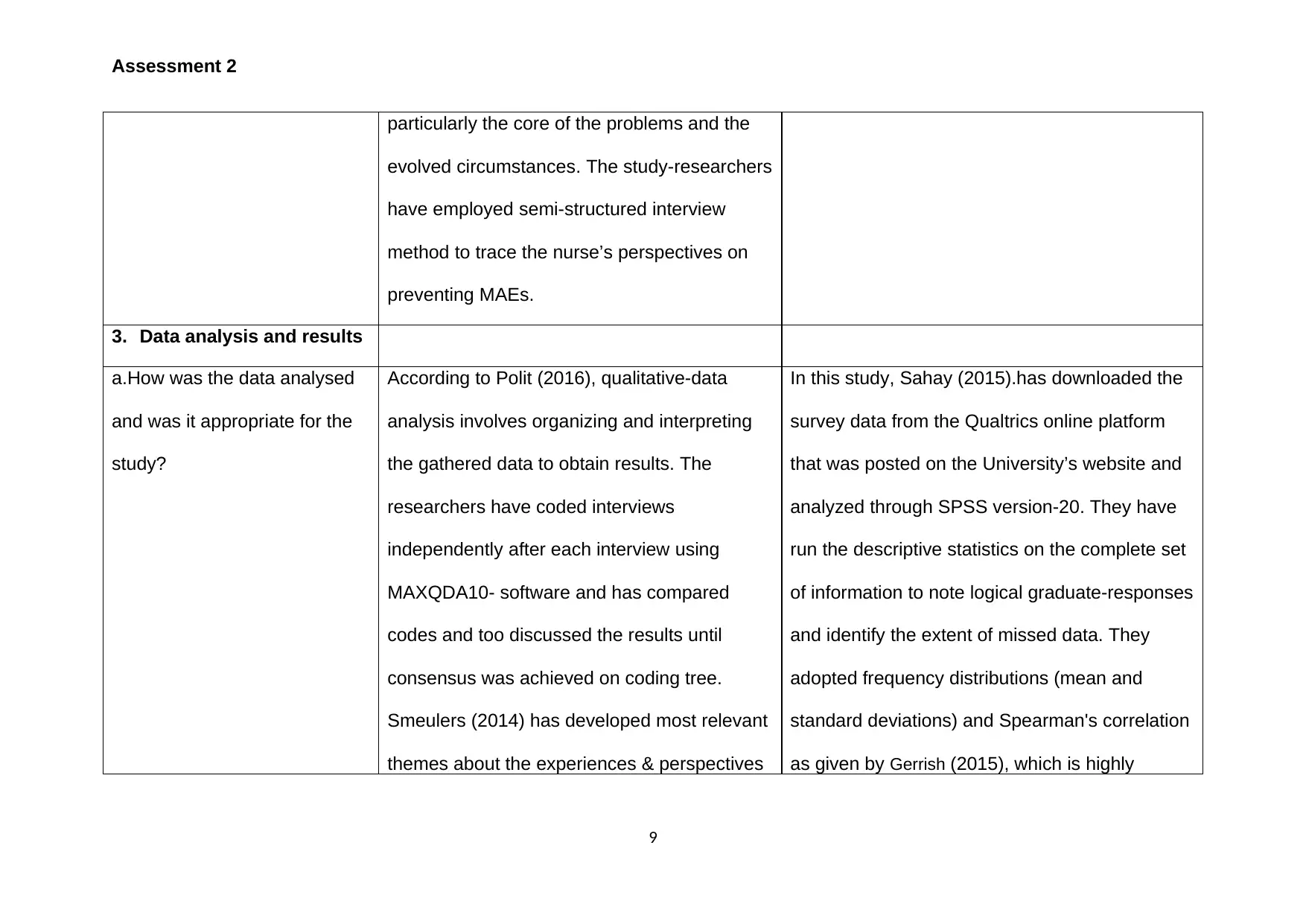
Assessment 2
particularly the core of the problems and the
evolved circumstances. The study-researchers
have employed semi-structured interview
method to trace the nurse’s perspectives on
preventing MAEs.
3. Data analysis and results
a.How was the data analysed
and was it appropriate for the
study?
According to Polit (2016), qualitative-data
analysis involves organizing and interpreting
the gathered data to obtain results. The
researchers have coded interviews
independently after each interview using
MAXQDA10- software and has compared
codes and too discussed the results until
consensus was achieved on coding tree.
Smeulers (2014) has developed most relevant
themes about the experiences & perspectives
In this study, Sahay (2015).has downloaded the
survey data from the Qualtrics online platform
that was posted on the University’s website and
analyzed through SPSS version-20. They have
run the descriptive statistics on the complete set
of information to note logical graduate-responses
and identify the extent of missed data. They
adopted frequency distributions (mean and
standard deviations) and Spearman's correlation
as given by Gerrish (2015), which is highly
9
particularly the core of the problems and the
evolved circumstances. The study-researchers
have employed semi-structured interview
method to trace the nurse’s perspectives on
preventing MAEs.
3. Data analysis and results
a.How was the data analysed
and was it appropriate for the
study?
According to Polit (2016), qualitative-data
analysis involves organizing and interpreting
the gathered data to obtain results. The
researchers have coded interviews
independently after each interview using
MAXQDA10- software and has compared
codes and too discussed the results until
consensus was achieved on coding tree.
Smeulers (2014) has developed most relevant
themes about the experiences & perspectives
In this study, Sahay (2015).has downloaded the
survey data from the Qualtrics online platform
that was posted on the University’s website and
analyzed through SPSS version-20. They have
run the descriptive statistics on the complete set
of information to note logical graduate-responses
and identify the extent of missed data. They
adopted frequency distributions (mean and
standard deviations) and Spearman's correlation
as given by Gerrish (2015), which is highly
9
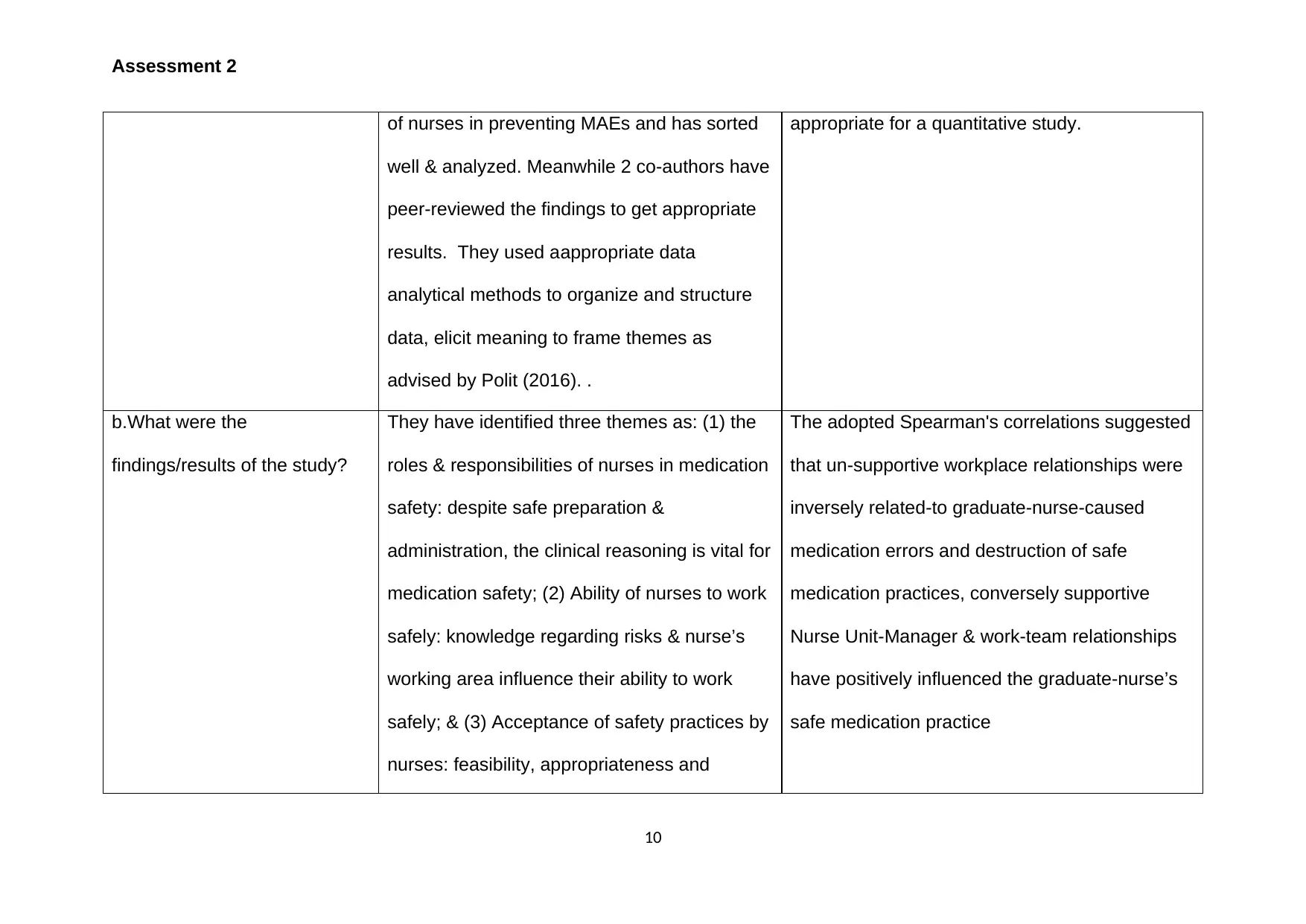
Assessment 2
of nurses in preventing MAEs and has sorted
well & analyzed. Meanwhile 2 co-authors have
peer-reviewed the findings to get appropriate
results. They used aappropriate data
analytical methods to organize and structure
data, elicit meaning to frame themes as
advised by Polit (2016). .
appropriate for a quantitative study.
b.What were the
findings/results of the study?
They have identified three themes as: (1) the
roles & responsibilities of nurses in medication
safety: despite safe preparation &
administration, the clinical reasoning is vital for
medication safety; (2) Ability of nurses to work
safely: knowledge regarding risks & nurse’s
working area influence their ability to work
safely; & (3) Acceptance of safety practices by
nurses: feasibility, appropriateness and
The adopted Spearman's correlations suggested
that un-supportive workplace relationships were
inversely related-to graduate-nurse-caused
medication errors and destruction of safe
medication practices, conversely supportive
Nurse Unit-Manager & work-team relationships
have positively influenced the graduate-nurse’s
safe medication practice
10
of nurses in preventing MAEs and has sorted
well & analyzed. Meanwhile 2 co-authors have
peer-reviewed the findings to get appropriate
results. They used aappropriate data
analytical methods to organize and structure
data, elicit meaning to frame themes as
advised by Polit (2016). .
appropriate for a quantitative study.
b.What were the
findings/results of the study?
They have identified three themes as: (1) the
roles & responsibilities of nurses in medication
safety: despite safe preparation &
administration, the clinical reasoning is vital for
medication safety; (2) Ability of nurses to work
safely: knowledge regarding risks & nurse’s
working area influence their ability to work
safely; & (3) Acceptance of safety practices by
nurses: feasibility, appropriateness and
The adopted Spearman's correlations suggested
that un-supportive workplace relationships were
inversely related-to graduate-nurse-caused
medication errors and destruction of safe
medication practices, conversely supportive
Nurse Unit-Manager & work-team relationships
have positively influenced the graduate-nurse’s
safe medication practice
10
Paraphrase This Document
Need a fresh take? Get an instant paraphrase of this document with our AI Paraphraser
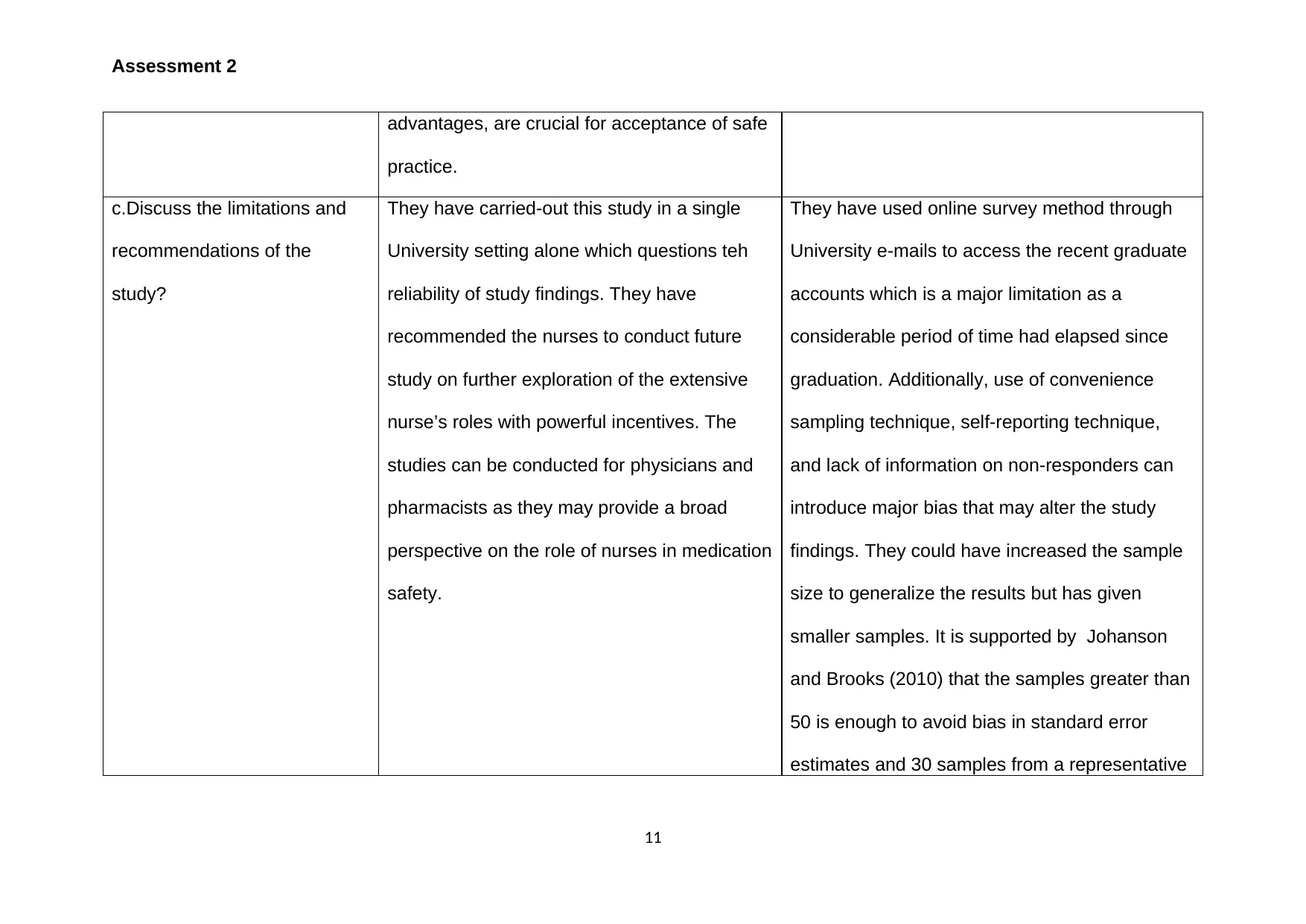
Assessment 2
advantages, are crucial for acceptance of safe
practice.
c.Discuss the limitations and
recommendations of the
study?
They have carried-out this study in a single
University setting alone which questions teh
reliability of study findings. They have
recommended the nurses to conduct future
study on further exploration of the extensive
nurse’s roles with powerful incentives. The
studies can be conducted for physicians and
pharmacists as they may provide a broad
perspective on the role of nurses in medication
safety.
They have used online survey method through
University e-mails to access the recent graduate
accounts which is a major limitation as a
considerable period of time had elapsed since
graduation. Additionally, use of convenience
sampling technique, self-reporting technique,
and lack of information on non-responders can
introduce major bias that may alter the study
findings. They could have increased the sample
size to generalize the results but has given
smaller samples. It is supported by Johanson
and Brooks (2010) that the samples greater than
50 is enough to avoid bias in standard error
estimates and 30 samples from a representative
11
advantages, are crucial for acceptance of safe
practice.
c.Discuss the limitations and
recommendations of the
study?
They have carried-out this study in a single
University setting alone which questions teh
reliability of study findings. They have
recommended the nurses to conduct future
study on further exploration of the extensive
nurse’s roles with powerful incentives. The
studies can be conducted for physicians and
pharmacists as they may provide a broad
perspective on the role of nurses in medication
safety.
They have used online survey method through
University e-mails to access the recent graduate
accounts which is a major limitation as a
considerable period of time had elapsed since
graduation. Additionally, use of convenience
sampling technique, self-reporting technique,
and lack of information on non-responders can
introduce major bias that may alter the study
findings. They could have increased the sample
size to generalize the results but has given
smaller samples. It is supported by Johanson
and Brooks (2010) that the samples greater than
50 is enough to avoid bias in standard error
estimates and 30 samples from a representative
11
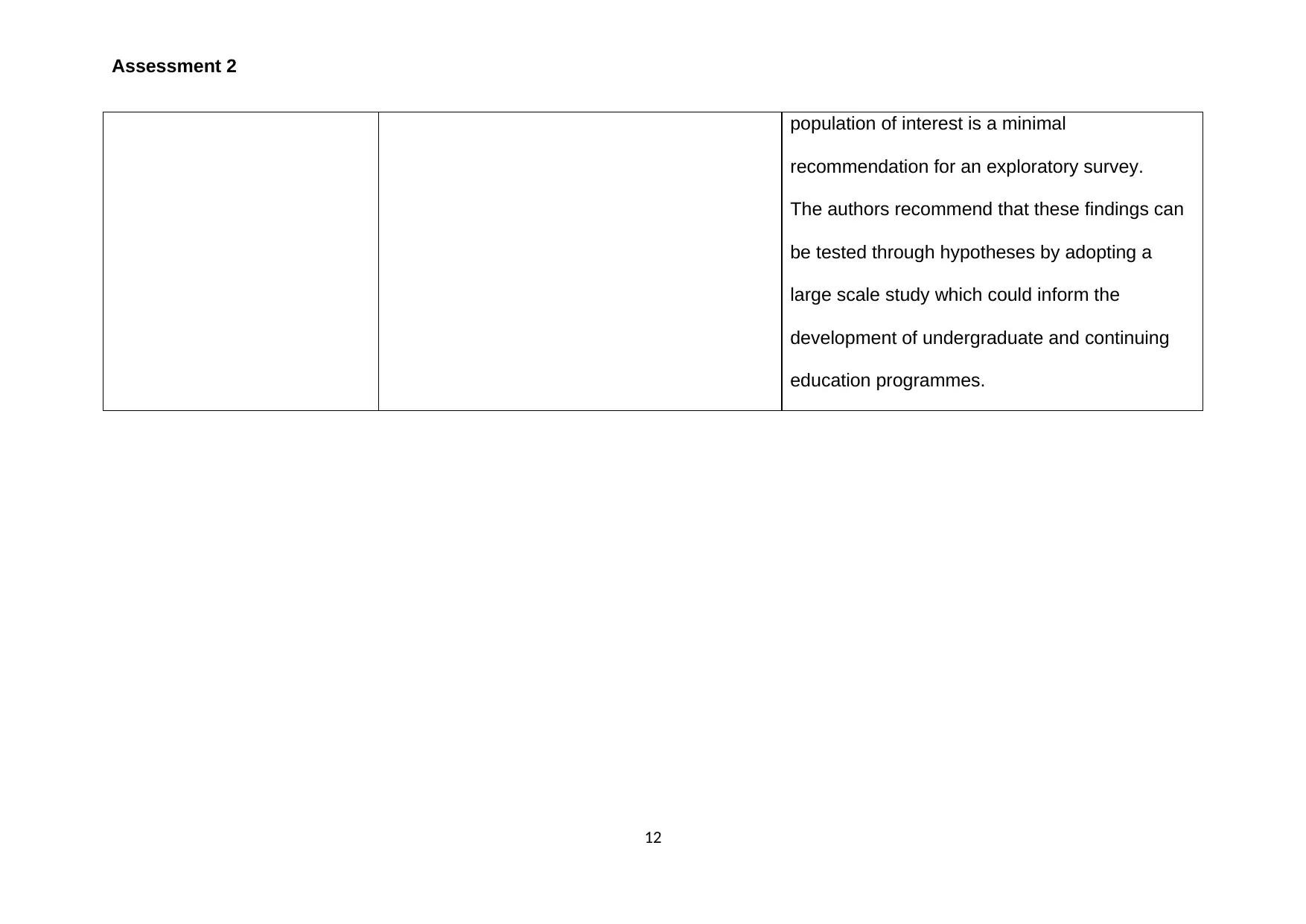
Assessment 2
population of interest is a minimal
recommendation for an exploratory survey.
The authors recommend that these findings can
be tested through hypotheses by adopting a
large scale study which could inform the
development of undergraduate and continuing
education programmes.
12
population of interest is a minimal
recommendation for an exploratory survey.
The authors recommend that these findings can
be tested through hypotheses by adopting a
large scale study which could inform the
development of undergraduate and continuing
education programmes.
12
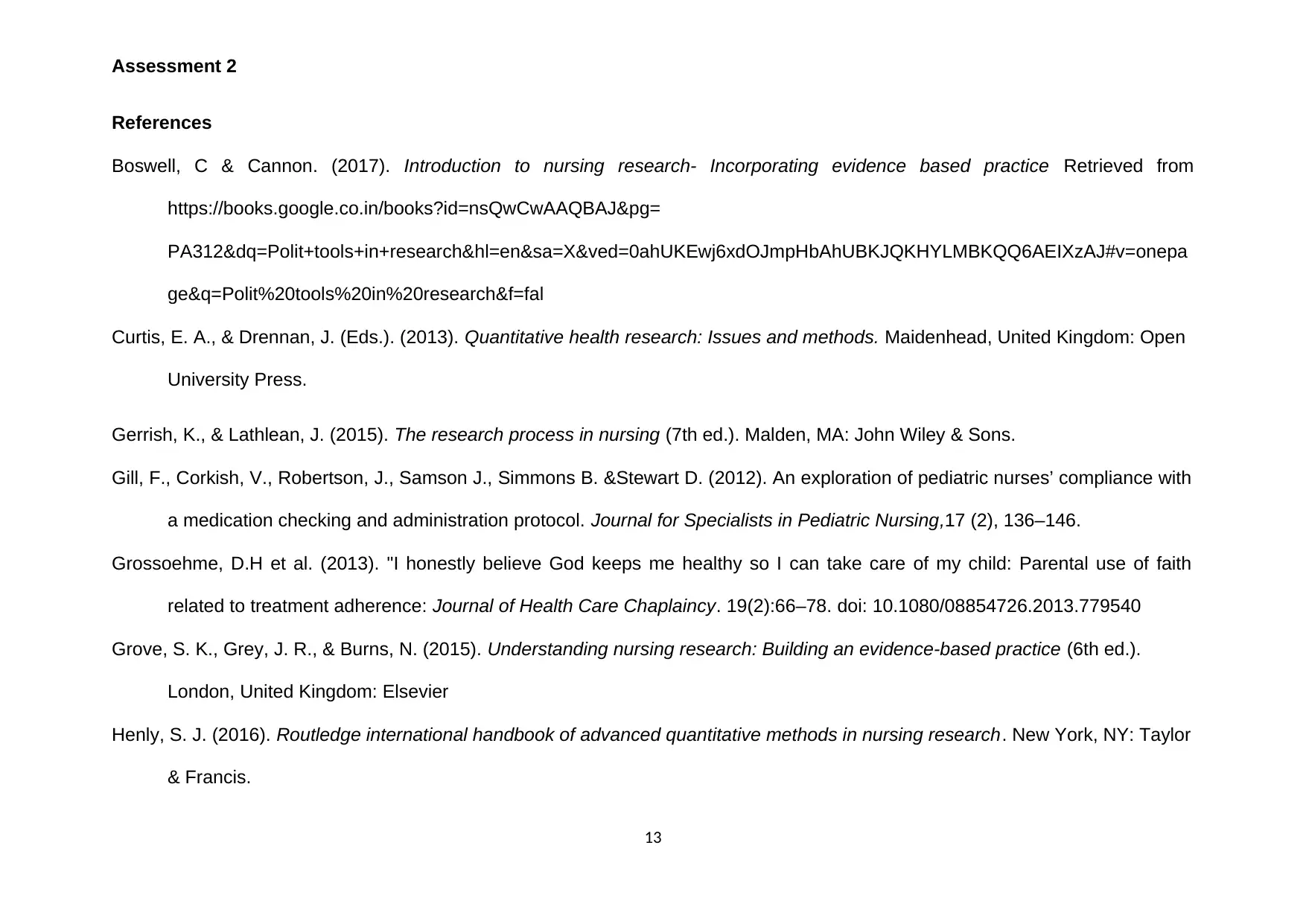
Assessment 2
References
Boswell, C & Cannon. (2017). Introduction to nursing research- Incorporating evidence based practice Retrieved from
https://books.google.co.in/books?id=nsQwCwAAQBAJ&pg=
PA312&dq=Polit+tools+in+research&hl=en&sa=X&ved=0ahUKEwj6xdOJmpHbAhUBKJQKHYLMBKQQ6AEIXzAJ#v=onepa
ge&q=Polit%20tools%20in%20research&f=fal
Curtis, E. A., & Drennan, J. (Eds.). (2013). Quantitative health research: Issues and methods. Maidenhead, United Kingdom: Open
University Press.
Gerrish, K., & Lathlean, J. (2015). The research process in nursing (7th ed.). Malden, MA: John Wiley & Sons.
Gill, F., Corkish, V., Robertson, J., Samson J., Simmons B. &Stewart D. (2012). An exploration of pediatric nurses’ compliance with
a medication checking and administration protocol. Journal for Specialists in Pediatric Nursing,17 (2), 136–146.
Grossoehme, D.H et al. (2013). "I honestly believe God keeps me healthy so I can take care of my child: Parental use of faith
related to treatment adherence: Journal of Health Care Chaplaincy. 19(2):66–78. doi: 10.1080/08854726.2013.779540
Grove, S. K., Grey, J. R., & Burns, N. (2015). Understanding nursing research: Building an evidence-based practice (6th ed.).
London, United Kingdom: Elsevier
Henly, S. J. (2016). Routledge international handbook of advanced quantitative methods in nursing research. New York, NY: Taylor
& Francis.
13
References
Boswell, C & Cannon. (2017). Introduction to nursing research- Incorporating evidence based practice Retrieved from
https://books.google.co.in/books?id=nsQwCwAAQBAJ&pg=
PA312&dq=Polit+tools+in+research&hl=en&sa=X&ved=0ahUKEwj6xdOJmpHbAhUBKJQKHYLMBKQQ6AEIXzAJ#v=onepa
ge&q=Polit%20tools%20in%20research&f=fal
Curtis, E. A., & Drennan, J. (Eds.). (2013). Quantitative health research: Issues and methods. Maidenhead, United Kingdom: Open
University Press.
Gerrish, K., & Lathlean, J. (2015). The research process in nursing (7th ed.). Malden, MA: John Wiley & Sons.
Gill, F., Corkish, V., Robertson, J., Samson J., Simmons B. &Stewart D. (2012). An exploration of pediatric nurses’ compliance with
a medication checking and administration protocol. Journal for Specialists in Pediatric Nursing,17 (2), 136–146.
Grossoehme, D.H et al. (2013). "I honestly believe God keeps me healthy so I can take care of my child: Parental use of faith
related to treatment adherence: Journal of Health Care Chaplaincy. 19(2):66–78. doi: 10.1080/08854726.2013.779540
Grove, S. K., Grey, J. R., & Burns, N. (2015). Understanding nursing research: Building an evidence-based practice (6th ed.).
London, United Kingdom: Elsevier
Henly, S. J. (2016). Routledge international handbook of advanced quantitative methods in nursing research. New York, NY: Taylor
& Francis.
13
Secure Best Marks with AI Grader
Need help grading? Try our AI Grader for instant feedback on your assignments.

Assessment 2
Iverson, K.M. (2014). Women veterans’ preferences for intimate partner violence screening and response procedures within the
Veterans Health Administration. Research in Nursing and Health, 37, 302-311
Johanson, A.G & Brooks, P.G. (2010). Initial scale development: sample size for pilot studies, Educ. Psychol, 70 (3), 394–400.
LoBiondo-Wood, G & Haber, J. (2014). Nursing Research: Methods and Critical Appraisal for Evidence-Based. Retrieved from
https://books.google.co.in/books?isbn=0323100864
Merriam, S. B., &Tisdell, E. J. (2016). Qualitative research: A guide to design and implementation (4th ed.). San Francisco, CA:
Jossey-Bass.
Polit, D.F & Beck, C.T. (2016). Nursing Research: Generating and assessing evidence for nursing practice. Lippincott Williams &
Wilkins: New Delhi.
Raban M.Z. & Westbrook J.I. (2013) Are interventions to reduce interruptions and errors during medication administration
effective?: a systematic review. BMJ Quality & Safety. doi:10.1136/bmjqs-2013-002118.
Sahay, A., Hutchinson, M., & East, L. (2016). Exploring the influence of workplace supports and relationships on safe medication
practice: A pilot study of Australian graduate nurses, Nurse Education Today, 35, e21-e26
Smeulers, M., Onderwater, A. T., Zwieten, M. C. B., & Vermeulen, H. (2014). Nurses' experiences and perspectives on medication
safety practices: an explorative qualitative study, Journal of Nursing Management, 22, 276-285
Yin, R.K. (2015). Qualitative Research from Start to Finish. Retrieved from https://books.google.co.in/books?isbn=1462521347
14
Iverson, K.M. (2014). Women veterans’ preferences for intimate partner violence screening and response procedures within the
Veterans Health Administration. Research in Nursing and Health, 37, 302-311
Johanson, A.G & Brooks, P.G. (2010). Initial scale development: sample size for pilot studies, Educ. Psychol, 70 (3), 394–400.
LoBiondo-Wood, G & Haber, J. (2014). Nursing Research: Methods and Critical Appraisal for Evidence-Based. Retrieved from
https://books.google.co.in/books?isbn=0323100864
Merriam, S. B., &Tisdell, E. J. (2016). Qualitative research: A guide to design and implementation (4th ed.). San Francisco, CA:
Jossey-Bass.
Polit, D.F & Beck, C.T. (2016). Nursing Research: Generating and assessing evidence for nursing practice. Lippincott Williams &
Wilkins: New Delhi.
Raban M.Z. & Westbrook J.I. (2013) Are interventions to reduce interruptions and errors during medication administration
effective?: a systematic review. BMJ Quality & Safety. doi:10.1136/bmjqs-2013-002118.
Sahay, A., Hutchinson, M., & East, L. (2016). Exploring the influence of workplace supports and relationships on safe medication
practice: A pilot study of Australian graduate nurses, Nurse Education Today, 35, e21-e26
Smeulers, M., Onderwater, A. T., Zwieten, M. C. B., & Vermeulen, H. (2014). Nurses' experiences and perspectives on medication
safety practices: an explorative qualitative study, Journal of Nursing Management, 22, 276-285
Yin, R.K. (2015). Qualitative Research from Start to Finish. Retrieved from https://books.google.co.in/books?isbn=1462521347
14
1 out of 14
![[object Object]](/_next/static/media/star-bottom.7253800d.svg)





